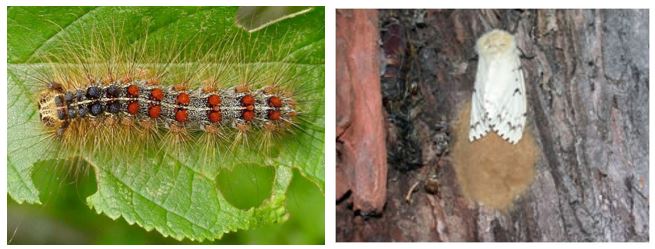About Gypsy Moth
Gypsy moth is an invasive species from Europe that attacks and defoliates many species of trees including maple, birch, oak, and elm. The Canadian Food Inspection Agency (CFIA) detected it in Winnipeg in 2012, and the City of Winnipeg and the Province of Manitoba eradicated it. It has not been detected in Manitoba since its eradication.
What to Look For
The caterpillars eat the leaves of most deciduous trees. When mature, they are 6-7 centimetres long and appear to be very hairy. They are dark in colour, with two rows of tubercles (bumps) along their back. The caterpillars can have either red and blue tubercles or all blue tubercles.
Adult male moths are brown and smaller than the females, which are white with black markings. The females do not fly, despite having wings, and lay their eggs in sheltered spots, including the underside of branches, fences, eaves troughs, wood piles, and bark crevices. The egg masses are the stage of the gypsy moth’s life cycle, which is most commonly found by the public.

Preventing Gypsy Moth
Look for Gypsy Moth Hitchhikers!
Vehicles and camping equipment accidentally transport gypsy moth. Egg masses are often laid on objects other than trees, including boats, trailers, barbeques, and tents. If travelling in eastern Canada (including Southern Ontario, Quebec, and the Maritimes) or the eastern United States, be sure to inspect your vehicles and equipment. If you find egg masses, contact the Canadian Food Inspection Agency (204-259-1400 is Manitoba’s regional office, for egg masses found here).
Don’t Transport Firewood – Burn It Where You Buy It!
Firewood should be burned where it was purchased to avoid bringing invasive pests back home.

